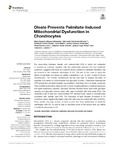Mostrar o rexistro simple do ítem
Oleate prevents palmitate-induced mitochondrial dysfunction in chondrocytes
| dc.contributor.author | Vázquez-Mosquera, María E. | |
| dc.contributor.author | Fernández-Moreno, Mercedes | |
| dc.contributor.author | Cortés-Pereira, Estefanía | |
| dc.contributor.author | Relaño, Sara | |
| dc.contributor.author | Dalmao-Fernández, Andrea | |
| dc.contributor.author | Ramos-Louro, Paula | |
| dc.contributor.author | Durán-Sotuela, Alejandro | |
| dc.contributor.author | Rego-Pérez, Ignacio | |
| dc.contributor.author | Blanco García, Francisco J | |
| dc.date.accessioned | 2021-09-30T10:13:56Z | |
| dc.date.available | 2021-09-30T10:13:56Z | |
| dc.date.issued | 2021-06-15 | |
| dc.identifier.citation | Vázquez-Mosquera ME, Fernández-Moreno M, Cortés-Pereira E, Relaño S, Dalmao-Fernández A, Ramos-Louro P, Durán Sotuela A, Rego-Pérez I, Blanco FJ. Oleate prevents palmitate-induced mitochondrial dysfunction in chondrocytes. Front Physiol. 2021 Jun 15;12:670753. | es_ES |
| dc.identifier.issn | 1664-042X | |
| dc.identifier.uri | http://hdl.handle.net/2183/28532 | |
| dc.description.abstract | [Abstract] The association between obesity and osteoarthritis (OA) in joints not subjected to mechanical overload, together with the relationship between OA and metabolic syndrome, suggests that there are systemic factors related to metabolic disorders that are involved in the metabolic phenotype of OA. The aim of this work is study the effects of palmitate and oleate on cellular metabolism in an “in vitro” model of human chondrocytes. The TC28a2 chondrocyte cell line was used to analyze the effect of palmitate and oleate on mitochondrial and glycolytic function, Adenosine triphosphate (ATP) production and lipid droplets accumulation. Palmitate, but not oleate, produces mitochondrial dysfunction observed with a lower coupling efficiency, maximal respiration and spare respiratory capacity. Glycolytic function showed lower rates both glycolytic capacity and glycolytic reserve when cells were incubated with fatty acids (FAs). The production rate of total and mitochondrial ATP showed lower values in chondrocytes incubated with palmitic acid (PA). The formation of lipid droplets increased in FA conditions, being significantly higher when the cells were incubated with oleic acid (OL). These results may help explain, at least in part, the close relationship of metabolic pathologies with OA, as well as help to elucidate some of the factors that can define a metabolic phenotype in OA. | es_ES |
| dc.description.sponsorship | This work was supported by grants from Fondo de Investigación Sanitaria (PI14/01254, PI16/02124, RETIC-RIER-RD16/0012/0002, and PRB3-ISCIII-PT17/0019/0014) integrated in the National Plan for Scientific Program, Development and Technological Innovation 2013–2016 and the ISCIII-General Subdirection of Assessment and Promotion of Research-European Regional Development Fund (FEDER) “A way of making Europe” and grant IN607A2017/11 from the Xunta de Galicia. The authors acknowledge AE CICA-INIBIC (ED431E 2018/03) for financial support. IR-P was supported by the Contrato Miguel Servet-II Fondo de Investigación Sanitaria (CPII17/00026) and AD was supported by grant IN606A-2018/023 from the Xunta de Galicia, Spain. The Biomedical Research Networking Center (CIBER) is an initiative from Instituto de Salud Carlos III (ISCIII). | es_ES |
| dc.description.sponsorship | info:eu-repo/grantAgreement/MINECO/Programa Estatal de I+D+I Orientada a los Retos de la Sociedad/PI14%2F01254/ES/Diseño de un modelo celular de cíbridos transmitocondriales para la búsqueda de biomarcadores epigenéticos para el diagnóstico de distintos fenotipos de artrosis | es_ES |
| dc.description.sponsorship | info:eu-repo/MINECO/Programa Estatal de I+D+I Orientada a los Retos de la Sociedad/PI16%2F02124/ES/Determinación de índices predictivos de diagnóstico y pronóstico de artrosis de rodilla mediante la validación de biomarcadores proteicos | es_ES |
| dc.description.sponsorship | info:eu-repo/grantAgreement/MINECO/Programa Estatal de I+D+I Orientada a los Retos de la Sociedad/RD16%2F0012%2F0002/ES/Red de Investigación en Inflamación y Enfermedades Reumáticas (RIER) | es_ES |
| dc.description.sponsorship | Xunta de Galicia; IN607A2017/11 | es_ES |
| dc.description.sponsorship | Instituto de Salud Carlos III; PT17/0019/0014 | |
| dc.description.sponsorship | Instituto de Salud Carlos III; CPII17/00026 | |
| dc.description.sponsorship | Xunta de Galicia; IN606A-2018/023 | |
| dc.language.iso | eng | es_ES |
| dc.publisher | Frontiers | es_ES |
| dc.relation.uri | https://doi.org/10.3389/fphys.2021.670753 | es_ES |
| dc.rights | Creative Commons Attribution 4.0 International License (CC-BY 4.0) | es_ES |
| dc.rights.uri | http://creativecommons.org/licenses/by/4.0/ | * |
| dc.subject | Osteoarthritis | es_ES |
| dc.subject | Chondrocyte | es_ES |
| dc.subject | Metabolism | es_ES |
| dc.subject | Fatty acids | es_ES |
| dc.subject | Mitochondria | es_ES |
| dc.subject | Lipid droplets | es_ES |
| dc.title | Oleate prevents palmitate-induced mitochondrial dysfunction in chondrocytes | es_ES |
| dc.type | journal article | es_ES |
| dc.rights.accessRights | open access | es_ES |
| UDC.journalTitle | Frontiers in Physiology | es_ES |
| UDC.volume | 12 | es_ES |
| UDC.startPage | 670753 | es_ES |
| UDC.coleccion | Investigación | es_ES |
| UDC.departamento | Fisioterapia, Medicina e Ciencias Biomédicas | es_ES |
| UDC.grupoInv | Grupo de Investigación en Reumatoloxía e Saúde (GIR-S) | es_ES |
| UDC.grupoInv | Reumatoloxía (INIBIC) | es_ES |
| UDC.institutoCentro | INIBIC - Instituto de Investigacións Biomédicas de A Coruña | es_ES |
Ficheiros no ítem
Este ítem aparece na(s) seguinte(s) colección(s)
-
Investigación (FFISIO) [508]







